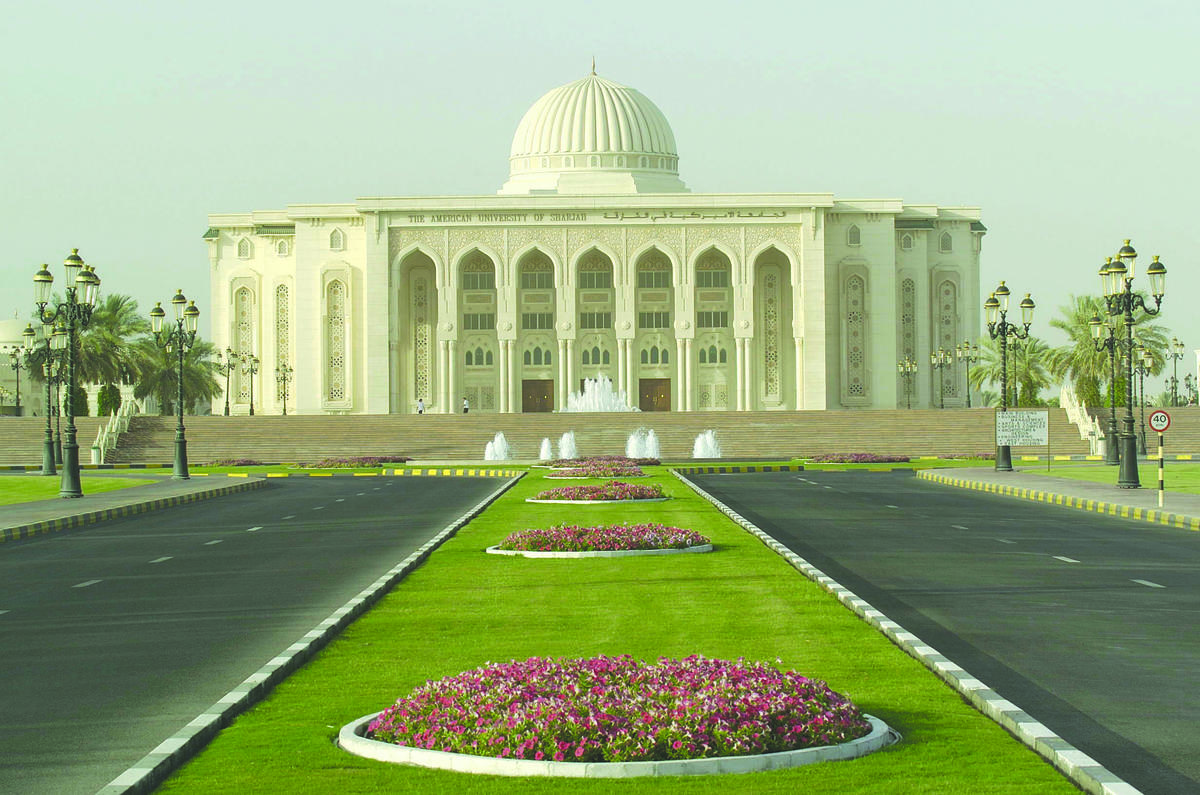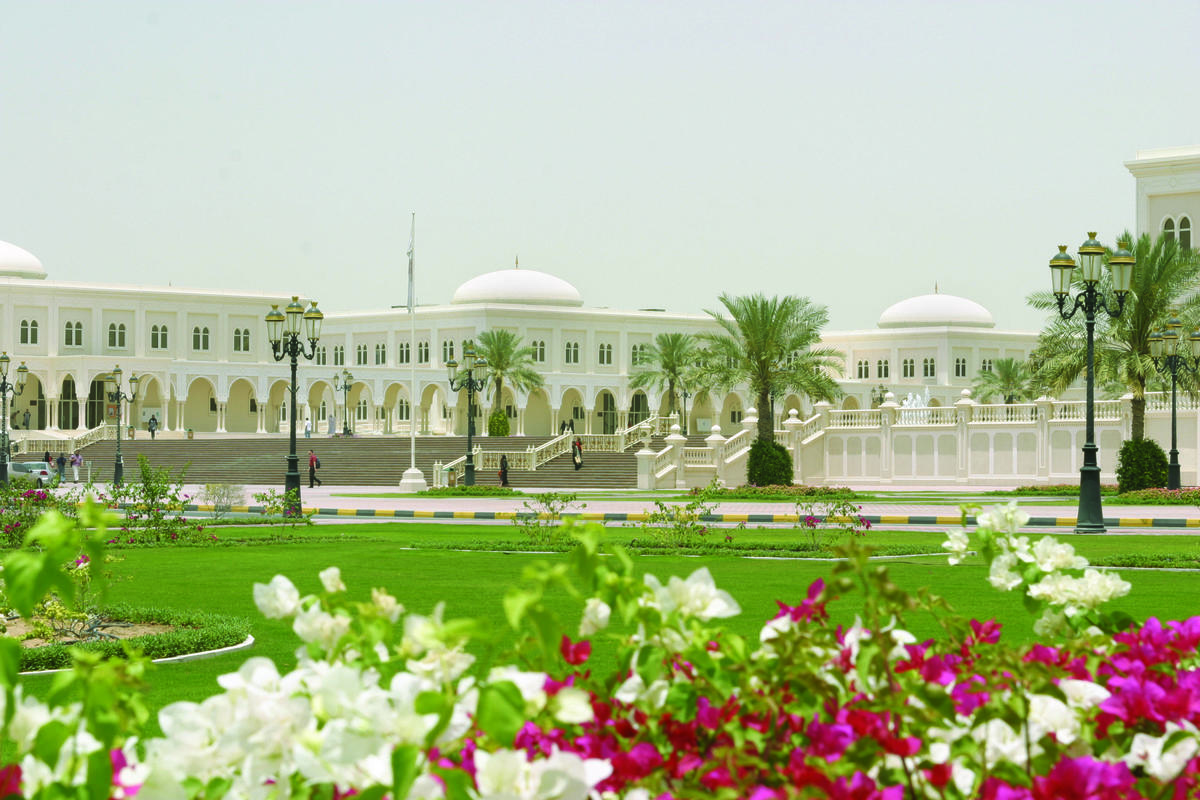
… Thirteen years since I first entered this place and I always till now still feel the absolute sharp divide between the outside and the inside every single time I walk in and out…
—Hassan Khan, 17 and in AUC (extract)
In the desert beyond Sharjah’s scrappy industrial sprawl lies the emirate’s eight-year-old University City. The American University sits at the top of a long, speed-bumped avenue of neat lawns, flanked by the lesser mortals of the higher education system — the police college, the women’s college, the arts college and so on. A kind of anytime, everywhere architecture, the imposing domed buildings sport myriad references cherry-picked from European, Middle Eastern and American classical traditions. In addition to the guards at the gate, who quiz me on my appointments and check my driver’s license, the only people who appear to occupy this Sim City are municipal gardeners, dressed in bright yellow jumpsuits, who are busy tweaking the sprinklers and manicuring the sections of grass.
Inside AUS’s courtyards, small groups of students scurry from one block to another, or gather around laptops, as if models in a promotional architectural program. Starbucks is rammed with the latte-sipping elite of the Arab world, Iran and Islamic Africa; in contrast the tiered Architecture and Design floors are reassuringly messy and industrious.
Entry to the Architecture and Design program is highly competitive: only twenty to thirty students graduate with a Bachelors in Architecture each year. The teaching is exceptionally intensive, and not every student makes it through the rigorous requirements. Most students live on campus and pay about $15,000–20,000 per year. Kevin Mitchell, Associate Dean of Academic Affairs in the School of Architecture and Design, notes that undergraduate commitment is generally exemplary; he currently has alumni studying at MIT, Harvard and Columbia.

For lecturers in the Arts and Humanities, the biggest hurdle is not students’ lack of drawing skills (given the paucity of arts courses in the local high schools), but instilling a “landscape of independent thinking.” One senior lecturer notes that at an earlier time, when students went from UAE universities to American graduate schools, it was “too late” to counteract the factual learning of the local education system with the golden ideals of breath, depth and critical thinking.
Peruse the CVs of any of the UAE’s top Arab business and governmental VIPs, and most will have attended a US university. They are perhaps evidence that the strong economy in Dubai, in particular, does encourage a return on its intellectual capital. The Middle East’s other major American universities in Beirut and Cairo help feed the Gulf’s rising brain gain, in particular its preference for western-educated Arabs; and the vast, active network of American University of Beirut (AUB) Alumni Associations in the US indicate that Lebanon has trouble hanging on to its “American” graduates.
The great export of American education began with AUB, founded under a charter from the State of New York in 1866. (As the Khalijees have risen from the dust, it’s struggled to retain its cliched status as the Harvard of the Middle East.) Its campus, however, partly rebuilt since the Civil War, retains that leafy, Ivy League aura of modish internationalism.
AUS is affiliated with the American University in Washington (AUW), and achieved the holy grail of full US accreditation (from Middle States, one of the main regional accrediting bodies) in 2004, around the same time as AUB. The AUW website describes AUS as “engaged in the experiment of growing an American-style institution in the soil of a traditional Islamic society.” Waxing lyrical about the KFC opposite the campus mosque, it’s the kind of hearts and minds stuff that nervous State Department officials presumably visualize to help them sleep at night.
As befits its place in the slickest of Arab capitals, attendees of the American University in Dubai, a branch campus of the American InterContinental University, Atlanta, are perhaps most akin to the Hollywood students in the film Clueless. The European ideal of the penniless intellectual is an anomaly here: the car park is a shiny homage to Lexus and BMW; engines chug as drivers wait to pick up their charges come the end of class.
Beyond Hard Rock Cafe and Starbucks, and the curricula and top staff, it’s hard to define what exactly makes these institutions American; after all, the AUS campus plays host to over 75 nationalities. Mitchell speaks of the need to engender constant debate about the university, its location and aims. Bidoun contributors who attended American schools and universities in the 1970s and early ‘80s look back wistfully on the days when McDonald’s was a symbol of unattainable chic, but today’s widespread Americana renders this consumer dream meaningless.
What’s changed in the past few years are the numbers of those who eschew a foreign education-with the requisite post-9/11 finger-printing and other immigration hassles-for a foreign education at home. In addition, more women are able to persuade their families of the values of further education. (Two thirds of students in the AUS Architecture and Design program are women.) Meanwhile, as private education has internationalized, teams of American university evaluators have begun traveling abroad.
The pressures on the likes of the American University in Cairo, built in 1919, come more from within, particularly from the country’s rapid population growth. In the next few years, the university is set to move to a vast, new, out-of-town campus.
In 2003, artist Hassan Khan, as part of a performance, video and book project titled 17 and in AUC, sat in a sound-proofed, one-way mirrored glass room in an old apartment every evening for two weeks, drinking, smoking and reminiscing about his undergraduate days in the early 1990s. His intimate monologue, later screened in video documentary form at his old university, critiques the institution that is both at the center of and yet wholly separate from Cairene life, and that, as Khan muses, is defined locally by both resentment and aspiration.
Describing himself as “spoiled by the promise of brilliance,” Khan expresses the universal crux of the intellectual Left, demonstrating against the elite while being of the elite. He speaks of “our super-contemporary urban privileged lifestyle,” which is influenced by “number one, the English language, and number two, American mass pop culture.” For Khan, students then and today are more defined by their class and privilege than their blurry relationship with a political notion of America. Even today’s AUC radicals, the Islamists, says Khan, appear to have little truck with their educational provider.
In some ways, the debates are reminiscent of those around the expansion of the World Trade Organization and US Free Trade Agreements in the Gulf. Western lefties, having absorbed all that footage from Seattle and Genoa, know that, fundamentally, the US-dominated Big Brother is a Bad Thing. But these cozy opinions aren’t shared by the (unofficial) spokesmen for South Asian laborers, who have embraced the idea of better-defined labor laws based on international standards, a condition the trade master would impose on Gulf rulers as part of its package.
Mindful of the value of service economy-oriented identities, both Qatar and Dubai are currently vying for the education card. Qatar’s educational ambitions are well established; the state is investing in cherry picking programs from the likes of Weill-Cornell Medical School, Texas A & M University and Virginia Commonwealth.
In the UAE, Dubai has launched Knowledge Village, Educational City and Harvard Medical School in Healthcare City, while US accreditation is being sought by the UAE for Zayed University, and, over the years (according to the Chronicle of Higher Education) the entire “public” education system. Of course, educators note that it’s a long shot but — to borrow a term usually applied to racism — their aim can be seen as a kind of institutional fetishism.
Presumably those well-rested State Department officials join lecturers in wondering how this new, larger generation of Western-educated graduates, emerging from their gated educational utopia, will impact on the traditional way of doing things in the Gulf.
The topic of accreditation is a current favorite along US educators, given the growing numbers of wannabe universities, especially from the Middle East; contributions to journals range from the enthusiastic to those that identify the growing trend as “academic neo-colonialism.” Some agreement on the quality of the (regional) independent American accreditation system exists; it relies on peer review, and universities like AUS operate on a non-profit-making basis. And the words of the US-based critics seem a far cry from the fervor of students in the Gulf for their gleaming facilities and “liberal education.”